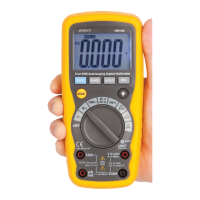9
DIODE TEST
WARNING: To avoid electric shock, do not test any diode that has voltage
on it.
1) Set the function switch to position.
2) Press the button until the symbol appears in the display.
3) Insert the black test lead banana plug into the negative (-) jack (COM).
4) Insert the red test lead banana plug into the positive (+) jack (VΩCAP).
5) Touch the test probe tips to the diode or semiconductor junction you
wish to test. Note the meter reading.
6) Reverse the probe polarity by switching probe position. Note this
reading.
7) The diode or junction can be evaluated as follows:
A) If one reading shows a value and the other reading shows OL, the
diode is good.
B) If both readings show OL, the device is open.
C) If both readings are very small or 0, the device is shorted.
NOTE: the value indicated in the display during the diode check is the
forward voltage.
CAPACITANCE MEASUREMENTS
WARNING: To avoid electric shock, disconnect power to the unit
under test and discharge all capacitors before taking any capacitance
measurements. Remove the batteries and unplug the line cords.
1) Set the function switch to the CAP position (“nF”) and a small value
will appear in the display).
2) Insert the black test lead banana plug into the negative (-) jack (COM).
3) Insert the red test lead banana plug into the positive (+) jack (VΩCAP).
4) Touch the test leads to the capacrtor to be tested. The display will
indicate the proper decimal point, value and symbol.
FREQUENCY MEASUREMENT
1) Set the function switch to the FREQ position.
2) Insert the black test lead banana plug into the negative (-) jack (COM).
3) Insert the red test lead banana plug into the positive (+) jack (VΩCAP).
4) Touch the test probe tips to the circuit under test.
5) Read the frequency in the display. The digital reading will indicate the
proper decimal point, symbols (Hz, kHz) and value.

